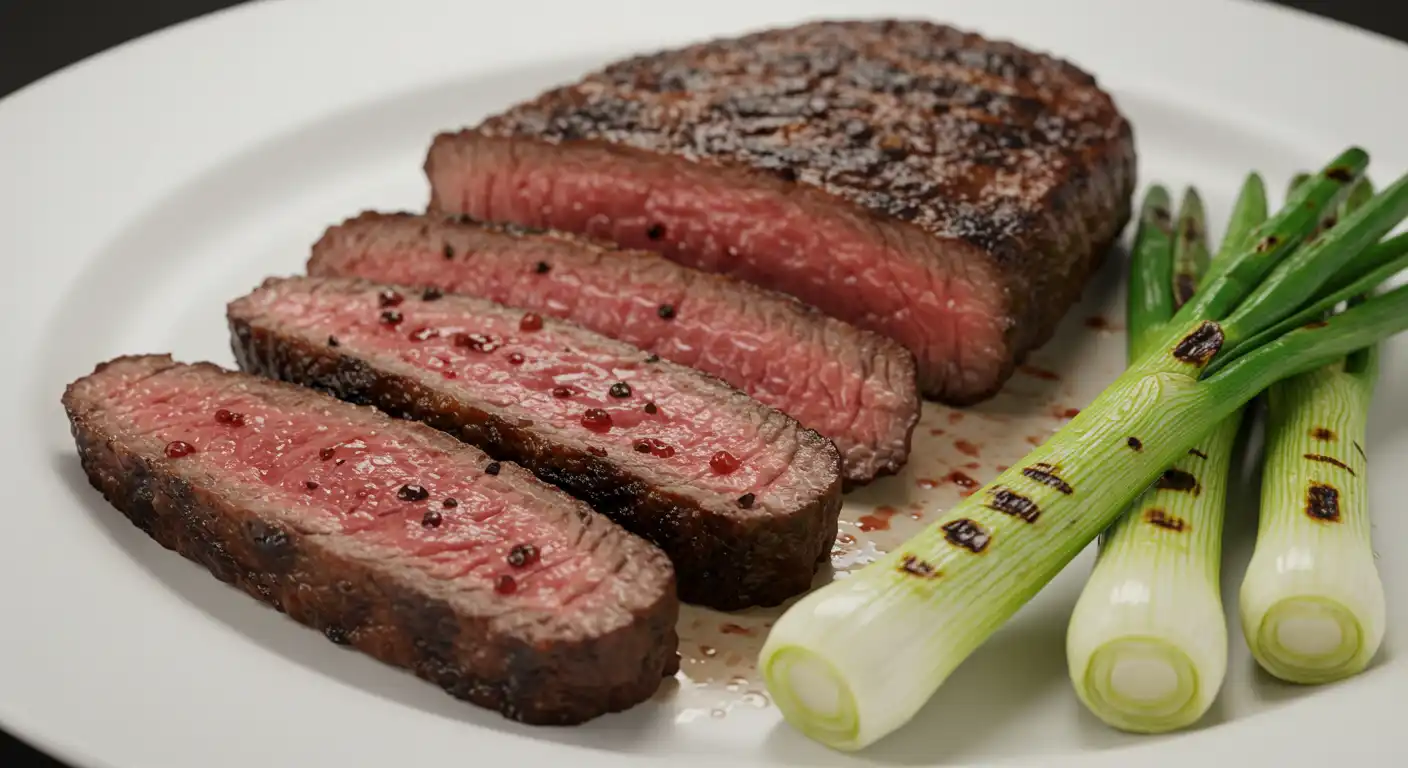I still remember the first time I cooked a beef loin flat iron steak—perfectly seared, juicy beyond belief, and so tender it practically melted on my fork. One bite, and I was hooked. Since then, this cut has become my go-to steak for everything from casual weeknight dinners to impressive meals that make my friends think I secretly trained in a steakhouse kitchen.
Here’s the thing—flat iron steak isn’t just delicious, it’s incredibly easy to cook. Whether you’re throwing it on the grill, searing it in a screaming-hot skillet, or slicing it up for tacos, this steak never disappoints. And today, I’m sharing all my favorite recipes, tricks, and insider tips to help you get that same perfect bite—every single time.
So grab your steak, fire up the heat, and let’s dive into the world of bold flavors and next-level tenderness. Trust me, once you master this cut, you’ll never look back! 🔥🥩
Table of Contents
What is Beef Loin Flat Iron Steak?
The origin and characteristics of flat iron steak.
Flat iron steak originates from the beef loin flat iron steak cut, specifically taken from the shoulder or chuck primal. Once considered a lesser-known cut, advancements in butchering techniques unlocked its remarkable tenderness. Unlike other chuck cuts, this steak boasts a fine grain and generous marbling, making it exceptionally flavorful. Its uniform thickness allows for even cooking, whether seared in a cast-iron skillet or grilled over an open flame. The beef loin flat iron steak delivers a rich, beefy essence with a buttery texture, rivaling premium cuts like ribeye. Proper slicing against the grain enhances its tenderness, ensuring a succulent bite every time.
How does it compare to other cuts like ribeye and sirloin?
The beef loin flat iron steak stands out as a hidden gem among premium cuts like ribeye and sirloin. Unlike ribeye, which boasts abundant marbling and a rich, buttery texture, the beef loin flat iron steak offers a balanced blend of tenderness and robust beef flavor without excessive fat. Compared to sirloin, it delivers a more velvety bite, thanks to its fine muscle fibers and even marbling. While ribeye excels in juiciness and sirloin in lean, beefy intensity, the beef loin flat iron steak strikes the perfect middle ground—succulent, flavorful, and incredibly versatile for grilling, searing, or sous vide cooking.
Why it’s a great choice for home cooking.
The beef loin flat iron steak is an excellent choice for home cooking due to its remarkable tenderness and ideal marbling. The fine muscle structure of this cut ensures a melt-in-your-mouth experience, even without the high-fat content found in more expensive steaks like ribeye. Its moderate marbling provides a perfect balance of juiciness and flavor, enhancing its versatility across various cooking methods. Furthermore, the beef loin flat iron steak is often more affordable than pricier cuts, making it a budget-friendly option for those seeking premium steak experiences at home. Its combination of quality, flavor, and price makes it a reliable choice for any cook.
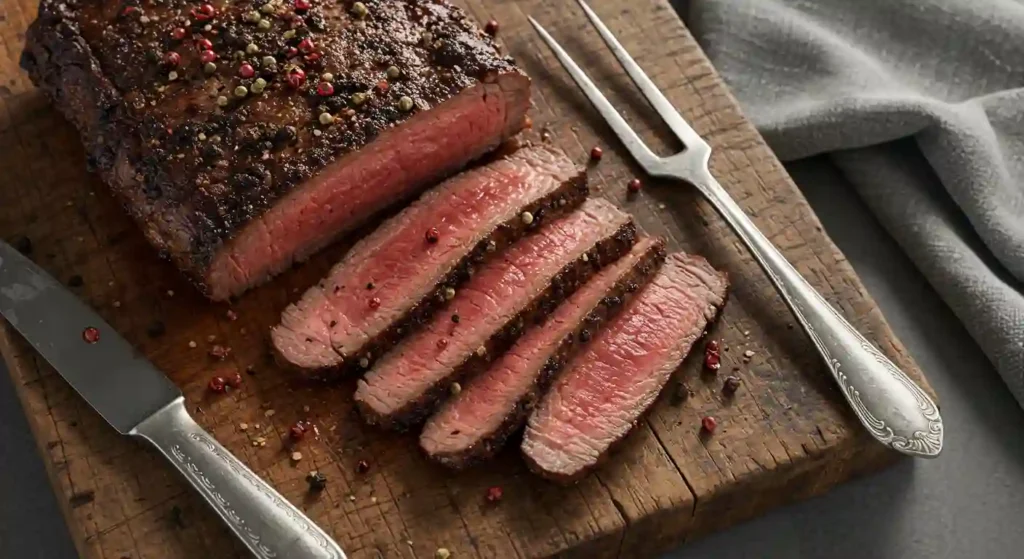
Choosing the Best Beef Loin Flat Iron Steak
USDA Grading: Prime vs. Choice vs. Select (quality differences).
USDA grading plays a crucial role in determining the quality of beef loin flat iron steak. Prime, the highest grade, represents the most marbled and tender cuts, offering exceptional flavor and juiciness. Choice, while slightly less marbled, still provides a rich, flavorful steak ideal for most home cooks. Select, the lowest grade, is leaner and lacks the marbling that gives steak its signature tenderness. For those seeking a perfect balance of flavor and price, a beef loin flat iron steak graded Choice often delivers a satisfying experience without the premium cost of Prime. Grading ensures you know exactly what you’re getting for your meal.
Grass-fed vs. grain-fed beef: Which one is better?
The debate between grass-fed and grain-fed beef often comes down to flavor, texture, and nutritional content. Beef loin flat iron steak from grass-fed cattle tends to be leaner, with a more robust, earthy flavor and a firmer texture due to the cow’s natural diet. In contrast, grain-fed beef is typically more marbled, resulting in a buttery, tender texture and a sweeter, milder taste. While grain-fed beef is often the preferred choice for its richness, grass-fed beef offers a leaner, more nutrient-dense option with higher omega-3 fatty acids and antioxidants. In the end, the decision comes down to individual taste and dietary objectives.
How to read steak labels and what to look for in a flat iron steak label.
Reading steak labels is essential to understanding the quality of your cut. When selecting a beef loin flat iron steak, look for the USDA grade, which indicates tenderness and marbling. “Prime” is the highest quality, offering the most marbling for juiciness and flavor, while “Choice” and “Select” are leaner options. The label may also include the beef’s source, such as “grass-fed” or “grain-fed,” which affects flavor and nutrition. Pay attention to the sell-by date for freshness and ensure the steak’s cut is clearly labeled. A well-informed purchase ensures a superior cooking experience and a flavorful beef loin flat iron steak.
Essential Tips for Cooking the Perfect Flat Iron Steak
Best cooking methods.
When cooking beef loin flat iron steak, several methods can elevate its flavor and tenderness. Grilling imparts a smoky, charred crust, perfect for enhancing the steak’s rich, beefy flavor. For a decadent, crispy exterior, pan-searing in a hot skillet with butter and garlic creates a mouthwatering crust while keeping the inside juicy. Alternatively, the sous vide method offers precise control over cooking temperatures, resulting in a perfectly tender steak. After sous vide, a quick sear on high heat adds a golden, caramelized finish. Each technique brings out unique qualities in the beef loin flat iron steak, making it a versatile and flavorful choice.
Why Wagyu Beef Tallow is a Game-Changer.
Wagyu Beef Tallow is a culinary game-changer when used to cook beef loin flat iron steak. Rich in monounsaturated fats, it imparts an incredible depth of flavor, elevating the steak with a buttery, melt-in-your-mouth quality. The high-fat content of Wagyu fat enhances the steak’s marbling, ensuring each bite is tender and succulent. When applied during cooking, Wagyu Beef Tallow helps create a golden, crispy crust, seals in the juices, and intensifies the natural beef flavor. Its luxurious texture and unique taste make it an ideal companion for any steak, turning a simple meal into an extraordinary experience.
The significance of allowing the steak to rest before slicing.
Letting a beef loin flat iron steak rest before slicing is crucial for achieving optimal tenderness and flavor. As the steak cooks, its juices move toward the center. Allowing it to rest for about 5–10 minutes lets these juices redistribute throughout the meat, ensuring each bite is moist and flavorful. If sliced too soon, these valuable juices escape, leaving the steak dry. This step is even more significant when using Wagyu Beef Tallow for cooking, as the fat helps lock in moisture. Resting enhances the steak’s overall texture and ensures that the rich, buttery flavor remains intact.
How to cut against the grain to ensure optimal tenderness.
Slicing against the grain is essential for maximizing the tenderness of your beef loin flat iron steak. The grain refers to the direction of the muscle fibers, which can make the steak tougher if sliced parallel to it. To achieve a melt-in-your-mouth texture, cut perpendicular to the grain, breaking up the long fibers. This method breaks down the muscle fibers, resulting in a more tender and easier-to-chew bite. When using Wagyu Beef Tallow to cook, the fat enhances the tenderness, and slicing correctly ensures you enjoy the full, buttery richness in every slice. This simple step transforms your steak experience.
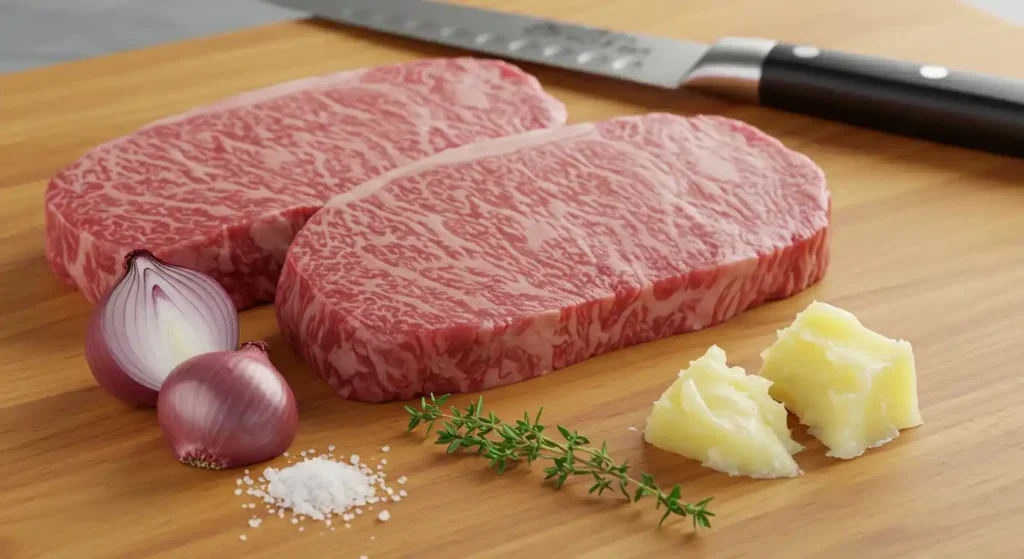
Best Beef Loin Flat Iron Steak Recipes
Classic Grilled Flat Iron Steak Recipe.
For a beef loin flat iron steak that’s simple yet bursting with flavor, grilling is an unbeatable method. Start by seasoning the steak generously with salt, pepper, and your favorite herbs. Preheat the grill to high heat, ensuring it’s hot enough to sear the steak’s surface. Grill the steak for about 4–5 minutes per side for medium-rare, adjusting time for desired doneness. Rest the steak for a few minutes before slicing to allow the juices to redistribute. This classic method highlights the natural beef flavor while providing a beautifully charred exterior and tender, juicy interior with minimal fuss.
Pan-Seared Flat Iron Steak with Garlic Butter.
Pan-searing a beef loin flat iron steak with garlic butter is a simple yet luxurious way to elevate the dish. Start by heating a cast-iron skillet with Wagyu Beef Tallow, allowing the rich fat to coat the pan. Once hot, add the steak and sear for about 4 minutes per side, creating a golden-brown crust. As the steak cooks, melt butter with minced garlic, thyme, and a sprig of rosemary in the pan. Baste the steak with the aromatic butter for added richness. After cooking, let the steak rest, and serve it with the infused garlic butter for a decadent finish.
Sous Vide Flat Iron Steak for Ultimate Tenderness.
Sous vide cooking offers unparalleled precision, ensuring the perfect tenderness for a beef loin flat iron steak. By sealing the steak in a vacuum bag and submerging it in a water bath at a consistent temperature, the meat gently cooks to your desired level of doneness without the risk of overcooking. For ultimate tenderness, cook the steak for 1 to 2 hours at 130°F (54°C) for medium-rare. Afterward, quickly sear the steak in a hot pan to develop a caramelized crust. The result is a perfectly cooked beef loin flat iron steak that’s juicy, tender, and bursting with flavor.
Flat Iron Steak Tacos with a Bold Marinade.
Beef loin flat iron steak tacos, marinated in a bold and flavorful mixture, offer a fresh take on a classic dish. Start by creating a marinade with lime juice, garlic, chili powder, cumin, and a dash of soy sauce for umami. Let the beef loin flat iron steak soak in the marinade for at least 30 minutes to infuse the meat with vibrant flavors. Grill or sear the steak to your preferred doneness, then slice it thinly against the grain. Serve the steak in warm tortillas, topped with fresh cilantro, onions, and a squeeze of lime, for a zesty, tender bite with every taco.
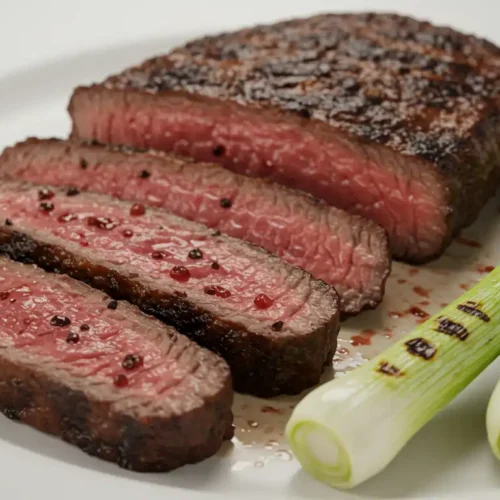
Classic Grilled Flat Iron Steak Recipe
Equipment
- Grill
- Tongs
- Meat thermometer
Ingredients
- Beef loin flat iron steak
- Salt
- Pepper
- Favorite herbs
- Wagyu Beef Tallow
Instructions
- Set your broiler to high (500°F) and position an oven rack 6 inches below the heating element, avoiding direct placement underneath. Line a rimmed baking sheet with foil for easier cleanup.
- Take the steak out of its packaging and place it on a cutting board. Use paper towels to pat it dry thoroughly.
- Lightly coat the steak with olive oil, then season both sides evenly with kosher salt, black pepper, garlic powder, and smoked paprika.
- Arrange the steak on the prepared baking sheet and broil for 6 minutes on the first side.
- Carefully flip the steak and continue broiling until it reaches medium-rare (135°F), approximately 6 more minutes. Use an instant-read thermometer to check for desired doneness.
- Move the cooked steak to a clean cutting board and let it rest for 5–10 minutes, loosely covered with foil. Slice thinly and serve.
Notes
To grill this steak, coat it in oil and season it with salt and pepper. Don’t use other spices – they will burn on the hot grill. Preheat your grill to medium-high and lightly oil it. Grill the steak for about 5 minutes per side for medium-rare (135°F) or to your desired doneness, checking with an instant-read thermometer to ensure it’s ready.
The CDC recommends cooking whole cuts of beef to an internal temperature of 145°F.
The leftovers keep well in the fridge, in an airtight container, for 3-4 days. You can reheat the leftovers in the microwave (covered, in 30-second intervals) or enjoy them cold.
Pro Tips for Elevating Your Flat Iron Steak
Perfect Steak Marinades & Seasonings.
A well-crafted marinade can elevate any beef loin flat iron steak into a flavorful masterpiece. A simple yet effective combination of olive oil, soy sauce, and Worcestershire sauce creates a rich, savory base that enhances the natural beef flavor. The olive oil provides a smooth texture, allowing the marinade to penetrate the meat, while the soy sauce adds depth with its umami richness. Worcestershire sauce brings a tangy, slightly sweet kick that balances the savory notes. Let the steak marinate for at least 30 minutes, and enjoy a tender, flavorful beef loin flat iron steak that’s perfectly seasoned and ready to impress.The CDC recommends cooking whole cuts of beef to an internal temperature of 145°F.
Use a meat thermometer to get the ideal steak doneness temperature.
Using a meat thermometer is essential for achieving the perfect doneness of a beef loin flat iron steak. To ensure a precise cook, insert the thermometer into the thickest part of the steak. For rare, aim for 120-125°F, medium-rare for 130-135°F, and medium for 140-145°F. For a well-done steak, it should be cooked to 160°F or more. This method removes the guesswork and ensures consistent results every time. With a beef loin flat iron steak, the right temperature guarantees maximum tenderness and flavor, preventing overcooking and drying out the meat. A meat thermometer is your best tool for steak perfection.
The Reverse Sear Method for a Perfect Crust.
The reverse sear method is an excellent technique for achieving a perfect crust on a beef loin flat iron steak. Begin by gently cooking the steak in the oven at a low temperature, around 250°F, until it reaches your desired internal temperature. This slow cooking ensures the steak is evenly cooked throughout. Once the steak is nearly done, transfer it to a hot skillet or grill to sear the exterior for 1-2 minutes per side. This method creates a beautifully caramelized, flavorful crust while maintaining the steak’s juicy tenderness. The result is a perfectly cooked beef loin flat iron steak with an irresistible outer texture.
Best side dishes to pair with flat iron steak.
When serving a beef loin flat iron steak, the right side dishes can elevate the entire meal. Classic choices like garlic mashed potatoes or roasted vegetables complement the rich, tender steak perfectly. A fresh, crisp salad with a tangy vinaigrette adds a refreshing contrast to the steak’s savory flavors. For a more indulgent option, creamy mac and cheese or buttery sautéed mushrooms pair wonderfully, enhancing the steak’s umami notes. Grilled asparagus or a light quinoa salad also works well, providing a balance of textures and flavors that allow the beef loin flat iron steak to shine as the star of the plate.
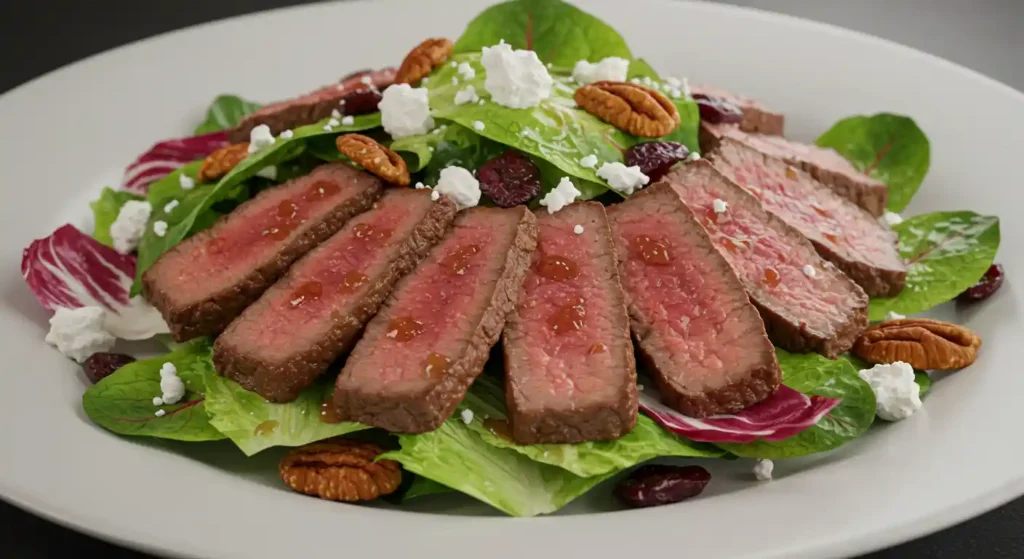
Frequently asked questions:
What are the best uses for beef flat iron steak?
Beef loin flat iron steak is versatile and works well for grilling, pan-searing, and even roasting. It’s ideal for dishes like steak sandwiches, salads, or tacos due to its tenderness and rich flavor. It can also be sliced thinly for stir-fries or served as a main course.
What’s the ideal method for cooking flat iron steak?
Flat iron steak is best cooked using high-heat methods like grilling or pan-searing to develop a flavorful crust while keeping the interior juicy. It can also be cooked sous vide for a perfectly tender result, followed by a quick sear. Always rest the steak before slicing to retain its juices.
How tender is flat iron steak compared to other cuts?
The beef loin flat iron steak is relatively tender due to its marbling, though not as tender as filet mignon. It has a fine grain and can be cooked to yield a juicy and tender texture when prepared correctly. It offers a great balance between tenderness and flavor compared to other cuts like sirloin or ribeye.
Is marinating necessary for flat iron steak?
Marinating beef loin flat iron steak is not strictly necessary, as the cut is already tender, but it can enhance its flavor. A marinade with acid (like vinegar or citrus) can help further tenderize and infuse additional taste. If you’re short on time, a simple seasoning rub can also work wonders.
What causes flat iron steak to be tough?
If cooked improperly, flat iron steak can become tough, especially if overcooked or sliced against the grain. Toughness can also result from not allowing the meat to rest after cooking, which leads to a loss of juices. Additionally, insufficient marbling or undercooking can affect the overall texture.
What are some effective ways to tenderize flat iron steak?
To tenderize beef loin flat iron steak, you can marinate it with acidic ingredients like citrus or vinegar, which break down muscle fibers. You can also use a meat mallet to gently pound the steak, which helps to loosen fibers. For the best results, cook it to medium-rare to avoid overcooking.
What’s the recommended oven temperature for cooking flat iron steak?
If cooking flat iron steak in the oven, preheat to 400°F (200°C). You can sear the steak in a hot pan first to develop a crust, then finish cooking it in the oven for about 6-8 minutes depending on thickness. Always check the internal temperature for the desired doneness.
How do you determine the perfect doneness for flat iron steak?
The ideal doneness for beef loin flat iron steak is medium-rare, with an internal temperature of 130-135°F (54-57°C). Use a meat thermometer to ensure accuracy, or apply the finger test to assess firmness. Rest the steak after cooking for the juices to redistribute for optimal flavor and tenderness.
Conclusion
In conclusion, beef loin flat iron steak offers a fantastic combination of tenderness and flavor, making it a top choice for a variety of cooking techniques. Whether grilling, pan-searing, or trying sous vide, the possibilities are endless. Remember, proper seasoning, marinating, and cooking to the right doneness are key to achieving the best results. Now, it’s the perfect moment to put these suggestions into action. Try one of the delicious recipes shared in this guide and experience the exceptional taste for yourself. Don’t forget to explore more beef recipes and cooking methods to elevate your culinary skills further!

